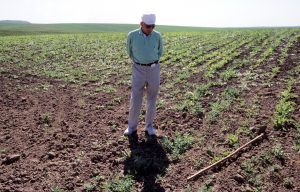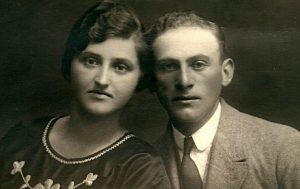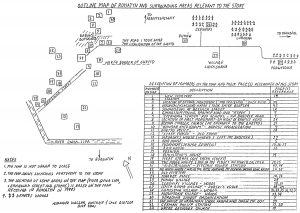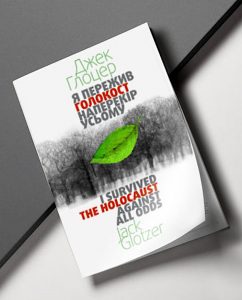![]() Ця сторінка також доступна українською.
Ця сторінка також доступна українською.
Jack Glotzer; I Survived the Holocaust Against All Odds: A Unique and Unforgettable Story of a Struggle for Life; (Джек Глоцер, «Я пережив Голокост наперекір усьому. Унікальна та незабутня історія боротьби за життя.»); bilingual edition; Kyiv: Ukrainian Center for Holocaust Studies, Library of Holocaust Memoirs, 2022.
Introduction
This page presents a remarkable memoir of Jewish life in Rohatyn and the surrounding region, before, during, and after World War II, by one of the rare surviving Jewish witnesses of nearly all phases of the German occupation of the town: Jack Glotzer. Jack called his memoir I Survived the German Holocaust Against All Odds, and reading his clear and careful record of his experiences reveals just how accurate that title is.
Links to free digital copies of the memoir in several formats are given below, in English, Ukrainian, and Polish. The featured format is a bilingual edition developed and published in 2022 by the Ukrainian Center for Holocaust Studies (UCHS) in Kyiv, with research and editorial support from Rohatyn Jewish Heritage (RJH) and complete funding for free distribution by the Connecting Memory program. All formats of the memoir are distributed under the Creative Commons Attribution-NonCommercial-NoDerivatives 4.0 International License, which specifies how the work may be used. The available formats are:
PDF: bilingual Ukr./Eng. (2022 edition), 4.4MB
PDF: Polish A4 format (2018 edition), 4.4MB
Hyperlinked text in English (2022 edition, on this website)
Hyperlinked text in Ukrainian (2022 edition, on this website)
To provide background to the memoir, this page also includes a brief summary of Jack’s life, a review of the memoir with Jack’s perspectives on his life experiences, and a map of Jack’s life during the war. A few remarks about the text of the memoir are also included here.
A Brief Summary of Jack’s Life
Jack Glotzer was born into an assimilated Jewish family in Rohatyn, at the beginning of 1925. He was the oldest of three children, all boys, born to one of Rohatyn’s several related Jewish butchers; the boys’ grandmother Leah Barban was a well-known and respected midwife who Jack recalls delivering the majority of babies in the town. Jack was part of a tightly-connected extended family which included his parents, uncles, aunts, and five cousins living together in a large house on a street connecting the Rohatyn town square with the Hnyla Lypa River; that street was then called “Church Street” because it connects two important historical Ukrainian churches (today the street is named for Mykhailo Kotsiubynsky).
Jack went by the nickname “Kuba” in Rohatyn, the diminutive of the Polish name Jakub, because it sounded more Slavic than his birth name Yankel, which brought him taunts from local Ukrainian children; he kept the name Kuba all of his life. Jack had both religious and secular schooling, and he became Bar Mitzvah in Rohatyn. In his memoir, Jack amusingly describes himself as an average student, but he shows sincere admiration for the scholastic achievements of his younger brothers, and great affection for his parents, his grandparents, and all of the members of his extended family. In 1937, when Jack was 12, Polish law changed to restrict Jewish ritual slaughter of animals, so his father left Rohatyn for America (where he had four sisters), in hopes of finding paying work and eventually obtaining visas to bring the rest of the family to join him there.
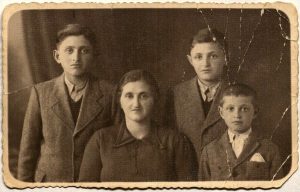
Jack’s family in Rohatyn. Left to right: Jack (Kuba), his mother Toba, his middle brother Samuel (Miko), and his youngest brother Moshe Emanuel (Munio). Source: Glotzer-Barban Family Collection.
Jack was 14 years old when Germany invaded western Poland and the Soviet Union occupied eastern Poland; he had recently completed his seven years of Polish elementary school. He worked for one of his uncles in a butcher shop, and did other small jobs in town; with his father gone to America, Jack served as his family’s head of household.
As elsewhere in eastern Poland, Germany’s invasion of Soviet-occupied lands in 1941 brought German soldiers and the Holocaust to Rohatyn. At ages 16 to 19, Jack witnessed and was threatened by everything the German occupation brought onto the Jews: frightened and starving refugees from the west; concentration of the Jewish community into a ghetto in Rohatyn (which enveloped the family home); repeated round-ups of Jews for deportation or execution; hiding in fear during armed raids; starvation and disease; individual shootings and mass slaughter; the violent deaths of nearly all of his family (including his mother and both brothers); escape to the forests and a life on the run for a year; betrayals and kindness; and survival to liberation – against all odds.
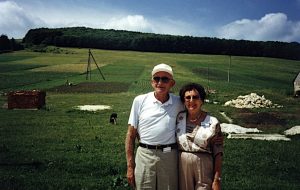
Jack and his wife Bea in 1998, visiting the forest near Lopushnia where he hid from 1943 to 1944. Source: Glotzer-Barban Family Collection.
Jack returned from the forests to Rohatyn with the Red Army in 1944, and was promptly drafted into military service. He served in armed units for almost two years, across Poland to the German border while the war continued, and in Bukovina after Germany surrendered, sometimes also serving as a guard of captured German soldiers. He was injured in battle, convalesced in Rohatyn, and returned again to Rohatyn after he was discharged in 1946. Because the Jewish community of Rohatyn had been destroyed, and the Soviet administration was preparing to move surviving Poles and Jews across the new border into Poland, Jack sold the family house in Rohatyn and traveled with his few surviving cousins to Poland, and then secretly crossed the border into the US Zone of Germany, into a series of Displaced Persons camps including in Berlin and Bayreuth. During his three years in the DP camps he communicated intermittently with his father and struggled to obtain papers to emigrate to America. He finally was permitted to emigrate, and arrived in America in 1949, only to learn that his father had died three months earlier.
Despondent, Jack struggled to make a new life in America, but brightened upon meeting his future wife Bronia (Beatrice, known as Bea) in 1950. A Holocaust survivor herself from Jarosław (200km west of Rohatyn), he could share his life experience with her. With Bea, Jack made a career and a family, raising two children who were named for his parents. After retirement, both Jack and Bea continued to speak about their experiences in the war, with students and others, to help teach tolerance. Jack and Bea traveled to Rohatyn in 1998 for the dedication of new memorial monuments at the Jewish mass graves, together with other survivors and descendants from Israel, North America, and elsewhere. Jack, Bea, and Bea’s brother Alexander Walzer assembled Jack’s memoir soon after. After Jack passed away in 2006 at age 81, Bea continued to visit classrooms and attend meetings to tell her story and Jack’s, and she joined the Rohatyn Jewish descendants group to carry Jack’s memory; she passed more recently, in 2017. Jack and Bea bequeathed their papers and their remarkable stories to their children, who hope to share them with a wider audience to further Jack and Bea’s efforts in history and tolerance.
Jack’s Perspectives on His Life Experiences
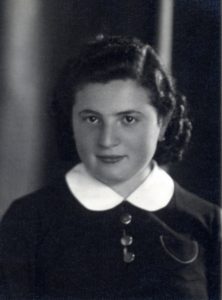
Jack’s cousin Clara Glotzer, a companion in part of his year-long life in the forests, was betrayed and killed with his brother two weeks before liberation. Source:
Glotzer-Barban Family Collection.
The memoir covers Jack’s life in Europe from 1925 to 1949, with a detailed accounting of his experiences in and around Rohatyn during the German occupation. The story is told chronologically, clearly and carefully, in a calm manner despite the emotional intensity of some of the events. The majority of the chronicle is reported in the first person, from events and conversations which Jack personally experienced. In some cases Jack relates events and information reported to him by trusted sources (usually close cousins) who witnessed things themselves; where he uses second-hand reports, Jack identifies them as such. The memoir was written more than 50 years after the events; although his memory is remarkably precise, where it falters he states so plainly, and does not invent details to fill missing names, places, or experiences. Together these features make Jack’s memoir an unusually useful reference to the wartime life of Rohatyn’s Jews.
With the original text, Jack included illustrations to graphically explain several aspects of his story. Among those are a family tree and a hand-drawn memory map illustrating the approximate locations of many of the places where events in the memoir took place. These supplemental illustrations are included in the new version of the memoir presented here.

Jack worked in the butcher shop of his aunt Esther and uncle Isidore Glotzer before the German occupation; they were killed in the Rohatyn ghetto with their children.
Source: Glotzer-Barban Family Collection.
By the time he was 21, Jack had seen extreme contrasts and experienced severe conflicts between people. He notes that as a boy, some of his best friends outside his family were Ukrainian, but labels other Ukrainians who were unfriendly toward Jews simply as antisemites. As military control of Rohatyn shifted rapidly after the outbreak of war, he reports the universal but varying abuse of Ukrainians, Poles, and Jews by the Soviet occupiers; at the other end of the war, he is alarmed at the exhausted and famished condition of the Red Army soldiers who liberate Rohatyn and its few surviving Jews from the Germans, and he is astonished at their own sad histories, of Russian villages burned and civilians murdered by the invaders. Over the course of his astounding tale, we read episodes of threats and betrayal but also shelter and food from the hands of Ukrainians; laughing scorn during slaughter but also life-saving protection at the risk of their own safety by Poles; mass murder but also empathy and even love in the actions of individual Germans. Jack himself was unable to suppress feelings of revenge for the treatment of his people in occupied Rohatyn, and plainly acknowledges his own harsh thoughts and actions as a soldier after liberation. Somehow Jack was able to integrate all of these contrasts and conflicts into a belief in “the victory of good over evil”.
An essential feature of the memoir is Jack’s focus on the interconnections within his family, and his love for and dependence on the trust and support of his relatives in Rohatyn, the region, and America. It was therefore particularly crushing for Jack to lose so many of his family, including his own mother and brothers, to the Holocaust in Rohatyn. In his video-recorded testimony for the USC Shoah Foundation, conducted in 1996, Jack breaks down in tears at times as he re-lives his wartime experiences and his personal losses. It is remarkable that someone who lost so much maintained and professed a strong core belief in humanity, and man’s ability to do good, through the decades of his post-war years. His efforts with his wife in his later years to teach the lessons of the Holocaust and encourage tolerance between nations are inspiring for our own work as well.
A Geography of Jack’s Wartime Life
Geography was one of Jack’s favorite subjects in school. Like many boys of similar age, in the late 1930s Jack had a very good mental map of his world, which included his neighborhood in Rohatyn and the parts of town that he visited for school, for work, and for leisure activities. Raised in a family of butchers (on his father’s side) and professionals and entertainers (on his mother’s side), Jack had visibility to the business and social world of Rohatyn. When the war came, and the German occupation, Jack’s world shrank into the ghetto, but he was one of a number of working-age Jews who was permitted passage out of the ghetto from time to time.
When the ghetto was liquidated in 1943, and almost of all of Jack’s Rohatyn family was killed, he and the few other Jewish survivors escaped the smoldering ghetto and fled into the nearby forests. Jack traveled east from Rohatyn, mostly living in wooded areas out of sight of settlements, but with frequent dangerous visits into villages to friendly families or to steal food. Shelter was sometimes in shallow bunkers dug for protection, sometimes in corn fields, sometimes simply among the trees. Many of Jack’s fellow escapees, including his own cousins, died during that year on the run.
By the time Jack wrote his memoir more than fifty years later, his recollection of the geographic relationships of many of these places had faded, and he was only able to document their approximate locations with the help of his brother-in-law Alexander Walzer. Some of the major landmarks are of course well known and easy to identify on modern maps. With additional information provided by historical maps and other Rohatyn Jewish memoirs, we have been able to improve a few other locations on Jack’s memory map. Several features remain only approximately known at this time.
On the interactive map below, the features from Jack’s memory map retain the numbering he gave them, and are sorted into groups by period: prewar and Soviet occupation (to 1941), the ghetto years (1941~1943), his year on the run (1943~1944), and his return to Rohatyn (both 1944 and 1998). Colors are used to identify places with Jewish significance (blue), German history (red), general non-Jewish features (green), and features which we are not able to precisely locate (yellow). This map may be edited in the future as new information is found to better locate some of the uncertain features.
You can also open this map in a new browser window, to size the view as large as you want.
About the Text
The first version of this memoir was completed by Jack Glotzer in 2000, with editing, typing, and illustration assistance from his wife Bea Glotzer and her brother Alexander Walzer. That first version was not formally published, but was circulated in photocopy format among Jack’s family and friends, including other Rohatyn Jewish survivors. A copy of the original was included in the Jack and Beatrice Glotzer Papers archived at the United States Holocaust Memorial and Museum, under accession number 1997.44. A digitized version of the original memoir is linked here as well.
A second edition was edited by RJH in 2018 and published by Jack’s children in an open digital format to enable wide distribution without cost to the reader; the PDF version of that edition is still available on our website and on the Internet Archive.
For a new and expanded third edition, which was developed within the publications program of the Ukrainian Center for Holocaust Studies (UCHS) and with significant support from the Connecting Memory project, we aimed to preserve Jack’s clear voice in his words and his story, while annotating the text from research by UCHS and RJH to provide additional historical and cultural context for both Ukrainian and English readers, correcting a small number of errors in the original text, and including a new scholarly introduction by UCHS director Dr. Anatolii Podolskyi. Significantly, the new edition now appears as an illustrated bilingual paper book printed by the UCHS for free distribution to libraries and schools in the Rohatyn area and beyond.
Developing this new book depended on the generous contributions of expertise and funding by many individuals and organizations, including: project proposals and mentoring by Olha Honchar, director of the Territory of Terror Museum in Lviv (as well as the Museum Crisis Center during the war); development and printing funding arranged by Svetlana Burmistr and Aleksandra Wroblewska of the Connecting Memory program; Ukrainian translation by Nataliya Kurishko, funded by Bolechow Jewish Heritage Society leaders Susan Wolf Turnbull, Bruce H. Turnbull, and Laurence S. Kirsch; research and editing by Vitalii Bobrov and Anatolii Podolskyi of UCHS with Marla Raucher Osborn and Jay Osborn of RJH; literary editing by Olena Paziuk in Ukrainian and by Rachel McRae of The Matzevah Foundation in English, with support from Anna Zolotniuk; computer layout by Maryna Kulikova; and cover design by Oleksandr Ostapov.
The book now appears as part of the growing UCHS Library of Holocaust Memoirs, a series of personal histories of the Shoah written by survivors and developed in Ukrainian translation to complement other pedagogical and scholarly publications on the Holocaust created and published by the UCHS as part of their efforts in research, education, and commemoration.
Personal memoirs are imperfect historical records; Jack’s memoir is no exception. His perspective as a child and young man growing up in Rohatyn was understandably narrow, reflected in his first-person point of view, without art or nuance but as a clear and honest report of his experiences and feelings. As noted above, it is shocking today to read, in the memoir’s first chapter on his childhood in Rohatyn, that Jack refers to local Ukrainian children as “antisemites” who made fun of him for the sound of his Yiddish name; some readers will be offended. Placed in context of the rising three-way ethnic strife in the tense interwar period in eastern Poland, Jack’s feeling and his language are easier to understand. Of course, pre-war childish taunts pale compared to the violent German occupation which followed; the raw horror of the Holocaust bears on the language of every personal memoir recorded decades later by Jewish survivors of Rohatyn’s wartime ghetto.
Additional References
As noted above, Jack gave a video-recorded interview with the USC Shoah Foundation in 1996; the VHA interview code is 20586. The later written memoir is more complete and detailed, but in the interview Jack expresses the emotions he worked hard to contain in his sober writing.
This page is part of a series on memoirs of Jewish life in Rohatyn, a component of our history of the Jewish community of Rohatyn.

